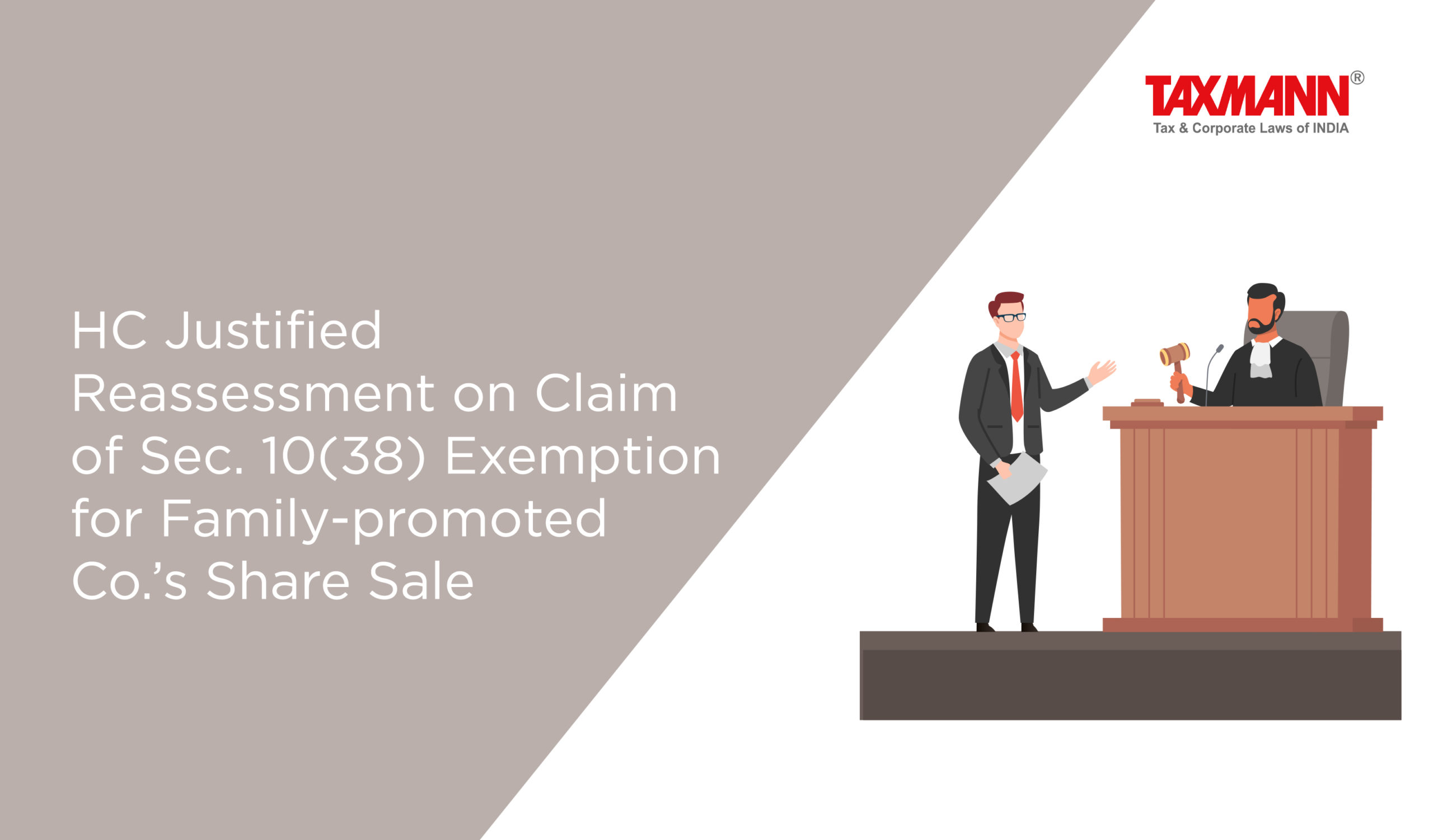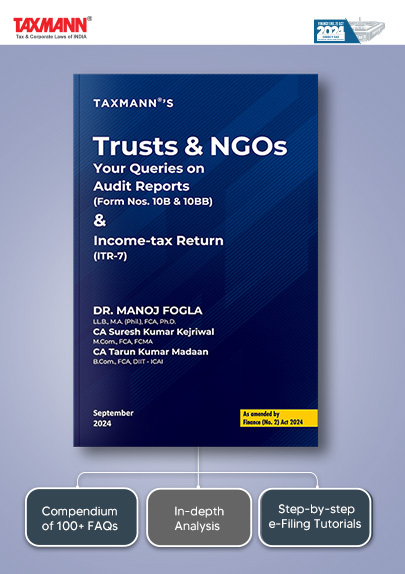HC Justified Reassessment on Claim of Sec. 10(38) Exemption for Family-promoted Co.’s Share Sale
- Blog|News|Income Tax|
- 3 Min Read
- By Taxmann
- |
- Last Updated on 18 July, 2023
Case Details: Munjal M Jaykrishna Family Trust v. ITO - [2023] 152 taxmann.com 38 (Gujarat)
Judiciary and Counsel Details
-
- N. V. Anjaria & Devan M. Desai, JJ.
- Darshan R. Patel for the Petitioner.
- Varun K. Patel for the Respondent.
Facts of the Case
The assessee-family Trust, received a notice under section 148. The assessment was sought to be reopened on the ground that there was information with the Assessing Officer (AO) that the assessee had claimed exemption under section 10(38) on the Sale of shares of two companies and promoters of both companies were family members of assessee group.
AO noticed that these promoters, the family members, off-loaded their holdings of shares in both companies through exchange in the financial year 2016-17. The promoter holding came to be transferred to the different Trusts created in the name of the family members. The beneficiaries of both the Trust appeared to be the promoter group itself.
It was claimed that the assessee had not disclosed the taxable income in the return of income and, therefore, the income chargeable to tax had escaped the assessment.
However, the assessee challenged the reassessment proceedings before Gujarat High Court on the ground that there was no link or connection of the relevant information in her case with the escapement of income.
AAR Held
The High Court held that when the AO proceeded to reopen the case based on reasons that the income chargeable to tax had escaped the assessment. The word ‘reason’ would imply the justifying facts available with the AO.
‘Reason to believe’ is a cause that may validly weigh with the AO to prima facie notice that the income had escaped assessment. The powers to reopen are liable to be exercised based on cogent probable facts and not based on established facts. If the AO has strong factual evidence indicating that income was not assessed correctly for the relevant year, he can legitimately use reassessment powers to issue the taxpayer under section 148.
It is well settled that the final ascertainment about the escapement of income is not necessary at this initial stage. What is only required is the formation of opinion based on prima facie but precise facts. Even where the AO had exercised powers to reopen the assessment, the assessee could well exercise his right to convince that the reasons weighed with the AO to reopen were not good and valid reasons and that there was no escapement of income.
At the stage of issuance of the notice, the only question to be addressed is whether relevant material is available based on which reasonable likelihood could be gathered that there was an escapement of income. Therefore, challenge to notice under section 148 was not justified.
List of Cases Referred to
-
- Chhugamal Rajpal v. S.P. Sharma [1971] 79 ITR 603 (SC) (para 4.1)
- CIT v. S. Goyanka Lime & Chemical Ltd. [2015] 64 taxmann.com 313/[2016] 237 Taxman 378 (SC) (para 4.1)
- India Gelatine and Chemicals Ltd. v. Asstt. CIT [2014] 52 taxmann.com 141/364 ITR 655 (Guj.) (para 4.1.1)
- Bankim Bhagwanji Chaauhan v. ITO [SCA No. 14021 of 2019, dated 23-3-2021] (para 4.1.1)
- Vijay Harishchandra Patel v. ITO [SCA No. 16171 of 2017, dated 5-9-2017] (para 4.1.1)
- Mumtaz Haji Mohmad Memon v. ITO [SCA No. 21030 of 2017, dated 21-3-2018] (para 4.1.1)
- Narendrakukar Mansukhbhai Patel v. ITO [2018] 92 taxmann.com 259 (Guj.) (para 4.1.1)
- Sagar Enterprises v. Asstt. CIT [2022] 124 Taxman 641/257 ITR 335 (Guj.) (para 4.1.2)
- Manishkumar Pravinbhai Kiri v. Asstt. CIT [SCA No. 15475 of 2015, dated 24-9-2015] (para 4.1.2)
- Giraben Atulbhai Shah v. Office of the Asstt. CIT [SCA No. 26 of 2022] (para 4.1.2)
- Mayur Dyechem Intermediates Ltd. v. Dy. CIT [SCA No. 18206 of 2021, dated 28-9-2022] (para 4.1.2)
- Parth Knitex (P.) Ltd. Pravinkumar Ramkaran Agarwal v. Dy. CIT [SCA No. 21107 of 2017, dated 27-2-2018] (para 4.1.2)
- Smt. Kalpana Shantilal Haria v. Asstt. CIT [Writ Petition (L) No. 3063 of 2017, dated 22-12-2017] (para 4.1.3)
- Asstt. CIT v. Rajesh Jhaveri Stock Brokers (P.) Ltd. [2007] 161 Taxman 316/291 ITR 500 (SC)/[2008] 14 SCC 208 (para 5.2)
- Raymond Woolen Mills Ltd. v. ITO [2008] 14 SCC 218 (para 5.3)
- ITO v. Selected Dalurband Coal Co. (P.) [1997] 10 SCC 68 (para 6.3).
Disclaimer: The content/information published on the website is only for general information of the user and shall not be construed as legal advice. While the Taxmann has exercised reasonable efforts to ensure the veracity of information/content published, Taxmann shall be under no liability in any manner whatsoever for incorrect information, if any.

Taxmann Publications has a dedicated in-house Research & Editorial Team. This team consists of a team of Chartered Accountants, Company Secretaries, and Lawyers. This team works under the guidance and supervision of editor-in-chief Mr Rakesh Bhargava.
The Research and Editorial Team is responsible for developing reliable and accurate content for the readers. The team follows the six-sigma approach to achieve the benchmark of zero error in its publications and research platforms. The team ensures that the following publication guidelines are thoroughly followed while developing the content:
- The statutory material is obtained only from the authorized and reliable sources
- All the latest developments in the judicial and legislative fields are covered
- Prepare the analytical write-ups on current, controversial, and important issues to help the readers to understand the concept and its implications
- Every content published by Taxmann is complete, accurate and lucid
- All evidence-based statements are supported with proper reference to Section, Circular No., Notification No. or citations
- The golden rules of grammar, style and consistency are thoroughly followed
- Font and size that’s easy to read and remain consistent across all imprint and digital publications are applied






 CA | CS | CMA
CA | CS | CMA


